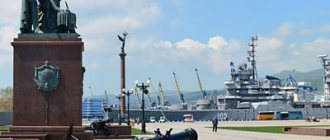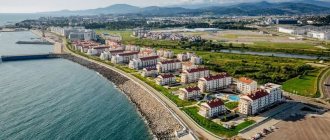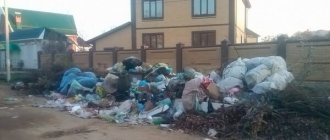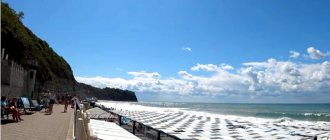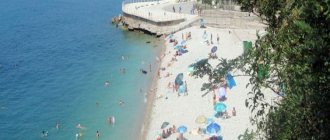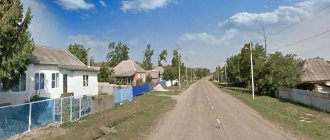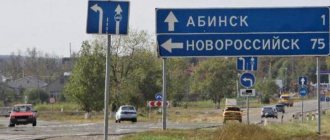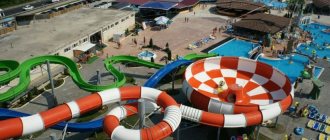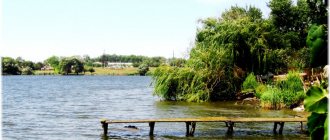Sochi city (Russia)
Sochi is a city in the south of Russia in the Krasnodar region, located on the Black Sea coast. It is the country's busiest seaside resort and host of the 2014 Winter Olympics. Sochi is called the resort or summer capital of Russia, as well as the “pearl of the Black Sea”. This is a colorful southern city, which is famous for its long coastline and wonderful beaches, warm and clean sea, delicious cuisine and picturesque nature.
Sochi is one of the largest cities on the entire Black Sea coast, which became widely known in the world after it was declared the capital of the 2014 Winter Olympic Games. This sporting event significantly influenced the life of the entire city and its infrastructure. Sochi is one of the fastest growing and dynamically developing resorts in Europe. The city receives about 4 million tourists annually. The vast majority of them are Russian citizens.
Enterprises and work in Sochi
In time immemorial, when there was nowhere for an apple to fall on the city’s beaches, Greater Sochi received 5 million vacationers a year. Well, the authorities know better, although this figure seems somewhat inflated. But that's not what this is about. All of these, even if a little less, people need to be accepted, housed, and fed.
Sochi beach
We think it’s already clear why Sochi has the lowest unemployment rate in the Krasnodar Territory. The basic sectors of the city's economy are: tourism, healthcare, trade and catering. The city needs a whole army of seasonal workers: waiters and photographers, drivers and fitness trainers. There are more than two hundred boarding houses, sanatoriums, hotels and tourist centers in the city. But this is not without problems. In winter, service personnel of many health resorts are sent on forced, partially paid or unpaid leave.
New hotels
Public catering in Sochi, in addition to traditional establishments, is represented by a large number of pizzerias, sushi bars, Baskin Robbins ice cream parlors, beer restaurants, and fast food chains: McDonald's, RICE, Subway, KFC.
Private brewery on the waterfront
We should not forget that all these establishments require not only cooks, bartenders, waiters, but also administrators, animators, office managers, hostesses, and sometimes managers.
Nowadays, even the smallest company is equipped with computer technology. Therefore, in Sochi, as elsewhere, IT specialists are in demand. The same can be said about specialists in the field of outdoor advertising, landscape designers, and foreign language teachers.
An enterprise of regional importance is the Sochi Meat Processing Plant. The plant is widely known outside of Sochi. It supplies its products to 85 cities in Russia. The company employs one and a half thousand people. Another thousand two hundred people are employed at one of the largest producers of bakery products in the region - Sochi Bread Factory OJSC. These enterprises, one might say, were lucky.
Sochi meat processing plant
When the privatization of food industry enterprises was allowed, the following were destroyed in the city: a fish processing plant, a dairy plant, and a confectionery factory. The production volume of the Adler poultry farm, the largest in the Krasnodar region, has decreased significantly. The Adler tea factory was demolished. All this does not contribute to increasing the number of jobs. One can only guess who benefits from all this.
The Adler Tea Factory stood on this site.
The huge influx of vacationers contributes to the development of the banking sector. We will not list all the banking institutions in Sochi, there are too many of them, let’s just say that these are mainly branches of large Krasnodar and Moscow banks. The salaries of bank employees, contrary to popular belief, are low, and the work schedule is complex.
Large-scale construction has led to an increase in the number of construction companies. And each of them requires an accountant. Some construction companies are willing to pay their accountants quite a decent amount of money. The main thing here is not to get a job in a fly-by-night company.
Thanks to the construction of Olympic facilities, Sochi became a city where a whole army of skilled workers was required: electrical installers, monolithic workers, reinforcement workers, concrete carpenters, formwork workers, and electric and gas welders. Unlike general workers, they received high salaries, and when working on a rotational basis, they received housing and food. Moreover, not only blue-collar jobs were in demand. The construction site needs geologists, architects, engineers of water supply and sewerage networks, heating and ventilation systems, and energy. Salaries at Olympic venues were much higher than the average salary in the city. The children of such specialists are provided with places in kindergartens and schools, and they are paid to live in rented apartments.
In general, let’s say right away that working in Sochi is difficult. When you look at the people crowding the beaches, bowling alleys, and restaurants, it’s hard to believe that they all worked for a whole year in order to spend the money they earned in a few days. The situation in the city, especially in the summer (read six months of the year), is perceived as a never-ending holiday. And not everyone is ready to work on holidays.
Guides: Russia
Moscow
Saint Petersburg
May be interesting: Other cities in Russia
Population of the urban district
| Population | ||||||
| 1887 | 1891 | 1897 | 1904 | 1916 | 1926[27] | 1932[27] |
| 98 | ↗460 | ↗1352 | ↗8163 | ↗13 254 | ↘13 000 | ↗17 010 |
| 1939[27] | 1959[27] | 1970[27] | 1979[27] | 1989[27] | 1992[27] | 1994[27] |
| ↗72 597 | ↗127 000 | ↗245 300 | ↗292 300 | ↗361 200 | ↗369 900 | ↗378 300 |
| 1997[27] | 2002[16] | 2006 | 2007 | 2008 | 2009[19] | 2010[20] |
| ↗388 200 | ↗397 103 | ↘395 012 | ↗402 043 | ↗406 800 | ↗410 987 | ↗420 589 |
| 2011[28] | 2012[22] | 2013[23] | 2014[24] | 2015[25] | 2016[26] | |
| ↗421 452 | ↗437 604 | ↗445 209 | ↗473 206 | ↘467 681 | ↗480 215 | |
Geography and climate
Sochi is located in the south of Russia on the northeastern coast of the Black Sea at a distance of 1600 km from Moscow and 300 km from Krasnodar. The city stretches for almost 100 km along the picturesque mountains of the Western Caucasus. From the southwest, Sochi is bounded by the Black Sea, from the east by the Psou and Mzymta rivers, from the north by the mountains of the Caucasus Range, and from the west by the valleys of the Magri and Shepsi rivers.
Panorama of Sochi
Sochi is the warmest city in Russia, having a humid subtropical climate characterized by hot summers and humid summers, as well as warm and rainy winters. Snow and frost are rare. From October to March there is a huge amount of precipitation (700-800 mm).
Forecast
Today, there are several dozen publications from large and authoritative sources - all studies predict an impressive growth in the population of Sochi. For example, according to forecasts by employees of the Department of Economics and Strategic Development, the population of the resort will increase by more than 100,000 people by 2030. Such predictions have a strong factual basis: about 6-7 thousand children are born on the Black Sea coast every year, and this is only a natural increase. Traditionally strong migration processes will have an even greater impact on the final number of residents of the resort center.
Tourist information
- Population - 444 thousand people (districts - 600 thousand people).
- Area - 176 km2 (Greater Sochi), 3506 km2 (urban district).
- The average altitude above sea level is 65 m.
- Administrative division - 4 districts: Khostinsky, Central, Adlersky and Lazarevsky.
- National composition: Russians (70%) and Armenians (20%). There is also a large share of ethnic Ukrainians, Georgians, Greeks, and Circassians.
Sochi coast
Ethnic composition
Modern indicators of the population and national composition of Sochi were formed during the Soviet Union, as a result of strong migration processes. Initially, until 1864, this land was inhabited by all kinds of peoples of the Western Caucasus: Shapsugs, Ubykhs, etc.
Also, the territory of the resort is considered the original homeland of the original Adyghe people: Adyghe, Kabardians, Circassians. After Russia's victory in the Crimean War of 1864, the ethnic composition of the city's population began to change towards Russification. By the end of the 19th century. The hospitable lands of the Black Sea coast have become home to peacefully living representatives of as many as 25 nationalities.
The last major All-Russian census, held in 2010, helped in compiling up-to-date statistics on ethnic composition. Of the nearly 421,000 respondents, more than 403,000 people indicated their nationality. Thanks to the research, it was possible to find out that the resort’s electorate consists of people who identify themselves with the following ethnic groups:
- Russians - 69.92%.
- Armenians - 20.09%.
- Ukrainians - 2.29%.
- Georgians - 2.03%.
- Adygs - 1.20%.
- Greeks - 0.82%.
In addition to these nationalities, Tatars, Belarusians, Abkhazians, Ossetians, Kazakhs, etc. live in the city, but their number as a percentage is less than 1%.
The best beaches in Sochi
- Riviera is a famous pebble beach in the central region of Sochi near the park of the same name.
- Imeretensky is a long beach in the south of Sochi, almost on the border with Abkhazia.
- Primorsky is another beach in the center of Sochi not far from the park. It has a length of more than 500 m.
- Albatross (locals call it Santa Barbara) is a wide pebble beach not far from the hotel of the same name.
- Del Mar is a chic paid beach on the main Sochi embankment.
- Beach of the Dagomys microdistrict with a clean area and convenient entrance to the sea. Length - 700 m.
- Blue Sea is a famous paid beach in the Central region of Sochi.
Sochi, Krasnodar region
The city of Sochi is located in the southwestern part of Russia, on the territory of the Krasnodar Territory. To the north is the Sea of Azov, where the border with Ukraine passes. In the south, the region borders on the Republic of Abkhazia. The Kuban River divides the territory into two halves. The northern part is represented in relief by plains. The capital city of Krasnodar is based on the Kuban River. To the south lie the mountains of the North Caucasus, the Main Caucasus Range. To the west extends the sea coast, where Sochi and other resort cities are located, as well as Novorossiysk, Russia’s main Black Sea port in this region.
Best time to visit
Sochi is the most popular resort in Russia. The beach season here lasts from June to October. In winter, the ski season begins in the mountains. The best time for a beach holiday is, of course, the period from July to September. The ski season usually starts in December and ends in the first half of spring.
Already in June, the water temperature in the Black Sea reaches 20 - 21 °C. By August the sea warms up to 25 - 26 °C. In September, the water temperature remains at a comfortable 22 - 24 °C.
Urbanization
The table shows the urban population of the microdistricts of Sochi proper. The municipal formation of the resort city of Sochi also includes an urban settlement and rural districts. The population of the municipality of the resort city of Sochi is 530,391 people. (2020), including:
Urban (within city limits: microdistricts) - 411.5 thousand people. (83.5%)
Gorodskoye (within the city limits and the urban-type settlement of Krasnaya Polyana) - 416.2 thousand people. (84.5%)
Rural (rural districts: villages, towns, auls) - 76.4 thousand people. (15.5%)
Dynamics of urban and rural population
84.56% of the population of the municipality live in urban areas (Sochi, Krasnaya Polyana).
Story
The territory of modern Sochi was inhabited thousands of years ago by mountain tribes and throughout its history was subjugated by the ancient Greeks, Romans, Byzantines and Ottomans. In 1829, after the Russian-Turkish War, the northeastern coast of the Black Sea was recaptured by the Russian Empire. In 1838, a military fort was founded here. This date is considered the founding day of Sochi.
Panorama of Sochi
Sochi received its modern name in 1896. Already at the beginning of the 20th century, this place began to enjoy the fame of a resort. In 1917, Sochi received city status and a railway. A new round of development of the city occurred in 1934, when under Stalin a large-scale reconstruction of the city was undertaken.
By the way, most of the city’s religious buildings date back to the Stalin period.
In 1961, the surrounding settlements were united into an urban district. After the collapse of the USSR, Sochi became the summer residence of the President of Russia. In 2007, the city received the right to host the Winter Olympics, and in 2014 it hosted the Olympics and Paralympics.
The role of A.S. Ermolov in the development of the Sochi resort
A.S. Ermolov stayed in Dakhovsky Posad
, making a long business trip through the annexed territory of the Caucasian Black Sea region.
After the end of the Caucasian War, several decades had already passed by this time, and no real development was observed in the annexed lands. In the village itself at that time there was only one fairly progressive organization - the Anglo-Indian Telegraph
, equipped with the most modern equipment.
After studying living conditions on the coast, Ermolov comes to the idea of the feasibility of developing a domestic resort
, as an alternative to existing European ones. Today Ermolov is considered the founder of the Sochi resort and there is a monument to him near the Summer Theater in the Frunze Park, which is located in the Svetlana Microdistrict of the Khostinsky district.
A bust of A. Ermolov was installed in the Park, which once bore his name
Inspired by the idea of creating a Caucasian resort, Ermolov devoted most of his life to this project. On his initiative, a Commission was created to develop the main provisions for the development of the Caucasus region, headed by N. Abaza
.
Indeed, for the development of the resort, it was necessary to resolve many issues related to the development of land, the construction of roads and water supply, the construction of hotels and boarding houses, the creation of beaches and health resorts. Dakhovsky Posad, renamed the city of Sochi, became the center of this long-term creative activity.
Ermolov himself, setting an example of philanthropy, bought a large plot of land along the sea, arranged a park area there and donated this park to the city! That Ermolovsky park today bears the name of the Hero of the Civil War M. Frunze.
Today the former Ermolovsky Park is a popular recreation spot
On Ermolov’s initiative, powerful highways were built - the Novorossiysk-Sukhumi highway and the road to Krasnaya Polyana. In addition, the Experimental Agricultural Station began to function as a nursery for the cultivation of subtropical crops, with which Ermolov wanted to plant the entire coast.
Also, under Ermolov, research began on the medicinal properties of Matsestinsky
and other local sources, as a result of which the Sochi-Matsestin region was recognized as Russian Nice.
The first medical buildings of Matsesta were quite modest
Large-scale resort construction began on the successfully sold lands of the Sochi coast at the beginning of the 20th century. Moreover, Ermolov personally supervised him, getting acquainted with the projects and demanding the use of the best European standards in construction.
And so, on the recently underdeveloped lands, the first baths in Matsesta begin to function, the first Sochi resort “Caucasian Riviera”
, which later became today's Riviera Park.
One of the first resort hotels in Sochi was very comfortable
Much credit for the design of the resort area in the former Dakhovsky Posad belonged to the hereditary Moscow merchant V.A. Khludov
. He invested most of his inheritance in the development of the park area, which today has become the famous Riviera Park.
For more information about the history of the development of this resort park, see the article Riviera Park.
In addition to the Riviera Park, other Sochi estates with exotic park areas that belonged to N. Mamontov
(almost destroyed) and
Khudekova
(now the Sochi Arboretum). These estates also decorated Sochi in the late 19th and early 20th centuries.
Monument to the founder of the Sochi Arboretum S. Khudekov
Ermolov repeatedly argued at meetings of the State Council the need to develop the Russian resort in order to improve the health of the nation. Ermolov also took the initiative to create the Russian Tourist Society, becoming its first chairman. Ermolov’s very active and active life, awarded with many awards, ended at the beginning of 1917.
How to get there
Sochi has an international airport located in the Adler region. It has regular connections with some cities in Europe and the CIS (Vienna, Istanbul, Tel Aviv, Minsk, Yerevan), as well as with most major cities in Russia: Moscow, St. Petersburg, Yekaterinburg, Tyumen, Surgut, Novosibirsk, Ufa.
Sochi is also a major railway junction. The city has two train stations and regular connections with other Russian cities. In the summer season, the number of destinations and their intensity increases.
Crime
Sochi authorities constantly report a decrease in crime in the city. But judge for yourself whether this can be. The city employs a large number of unskilled workers between the ages of twenty and forty. Some of them have a criminal past, which employers have little interest in. Many of those who came to work on the construction of Olympic facilities expected exorbitant wages. We don’t argue that in some places construction sites pay good money, but only to skilled workers and engineering and technical personnel.
What do you order the builders to do when wages were delayed at the Olympic venues? People who came to Sochi to improve their family’s well-being do not even have enough money to return home. Some people go on strike to seek the truth, others commit crimes. We are not making excuses, we are stating a well-known fact: along with the Olympic construction, the number of crimes in Sochi has only increased. This is especially true for crimes related to encroachment on the property of citizens.
Fisht Stadium. Photo by natalia (https://fotki.yandex.ru/users/nnp1603/)
The installation of CCTV cameras provided for by the Safe City program did not produce much results. Every second crime in the city is not solved. But one such camera, including maintenance, costs about three hundred thousand rubles.
They say that the cream of the Olympic pie was shared not only by the government, but also by the criminal world. Who knows, maybe that’s why the number of crimes involving firearms has increased in Sochi. But we were much more shocked by another crime.
On the night of August 6, 2010, in the Golubye Dali microdistrict of the Adler region, a 70-year-old old woman and her 17-year-old grandson were brutally murdered. After the crime was committed, the apartment was set on fire. A minor student, Ilya Orlov, and his grandmother received several stabbing wounds, the pensioner’s hands were tied behind her back. It turned out that the old woman had witnessed a crime. Moreover, having seen how the girl was being raped, the woman began to shout that she remembered the criminals. For which she paid with her life, and not only her own. It turns out that in order to protect your loved ones, you need to remain silent more... The conclusions are not encouraging.
Purchases
Large shopping centers:
- Moremall
- City Plaza
- Gorki mall
- Mandarin
- Sun City
Markets:
- Central market on Moskovskaya
- Adler market on Democracy.
What to buy in Sochi: leather goods, crafts made from boxwood and juniper, tea, wine, churchkhela, honey, spices, nuts and dried fruits.
Sochi
An excerpt characterizing the population of Sochi
When Rostov entered the room, the princess lowered her head for a moment, as if giving time to the guest to greet his aunt, and then, at the very time Nikolai turned to her, she raised her head and met his gaze with sparkling eyes. With a movement full of dignity and grace, she stood up with a joyful smile, extended her thin, gentle hand to him and spoke in a voice in which for the first time new, feminine chest sounds were heard. M lle Bourienne, who was in the living room, looked at Princess Marya with bewildered surprise. The most skillful coquette, she herself could not have maneuvered better when meeting a person who needed to please. “Either black suits her so well, or she really has gotten so prettier and I didn’t notice. And most importantly – this tact and grace!” - thought m lle Bourienne. If Princess Marya had been able to think at that moment, she would have been even more surprised than M lle Bourienne at the change that had taken place in her. From the moment she saw this sweet, beloved face, some new force of life took possession of her and forced her, against her will, to speak and act. Her face, from the time Rostov entered, suddenly changed. How suddenly, with unexpected, striking beauty, that complex, skillful artistic work appears on the walls of the painted and carved lantern, which previously seemed rough, dark and meaningless, when the light is lit inside: so suddenly the face of Princess Marya was transformed. For the first time, all that pure spiritual inner work with which she had lived until now came out. All her inner work, dissatisfied with herself, her suffering, desire for good, humility, love, self-sacrifice - all this now shone in those radiant eyes, in her thin smile, in every feature of her gentle face. Rostov saw all this as clearly as if he had known her all her life. He felt that the creature in front of him was completely different, better than all those he had met so far, and better, most importantly, than himself. The conversation was very simple and insignificant. They talked about the war, involuntarily, like everyone else, exaggerating their sadness about this event, they talked about the last meeting, and Nikolai tried to divert the conversation to another subject, they talked about the good governor’s wife, about the relatives of Nikolai and Princess Marya. Princess Marya did not talk about her brother, diverting the conversation to another subject as soon as her aunt spoke about Andrei. It was clear that she could talk about the misfortunes of Russia feignedly, but her brother was a subject too close to her heart, and she did not want and could not talk lightly about him. Nikolai noticed this, just as he, with an astute observation unusual for him, noticed all the shades of Princess Marya’s character, which all only confirmed his conviction that she was a very special and extraordinary creature. Nikolai, just like Princess Marya, blushed and was embarrassed when they told him about the princess and even when he thought about her, but in her presence he felt completely free and said not at all what he had prepared, but what instantly and always opportunely came to his mind. During Nikolai's short visit, as always, where there are children, in a moment of silence Nikolai ran to Prince Andrei's little son, caressing him and asking if he wanted to be a hussar? He took the boy in his arms, began to twirl him cheerfully and looked back at Princess Marya. A tender, happy and timid gaze followed the boy she loved in the arms of her loved one. Nikolai noticed this look and, as if understanding its meaning, blushed with pleasure and began to kiss the boy good-naturedly and cheerfully. Princess Marya did not go out on the occasion of mourning, and Nikolai did not consider it proper to visit them; but the governor’s wife still continued her matchmaking business and, having conveyed to Nikolai the flattering things that Princess Marya had said about him, and back, insisted that Rostov explain himself to Princess Marya. For this explanation, she arranged a meeting between the young people at the bishop's before mass. Although Rostov told the governor’s wife that he would not have any explanation with Princess Marya, he promised to come. Just as in Tilsit, Rostov did not allow himself to doubt whether what was recognized by everyone as good was good, so now, after a short but sincere struggle between an attempt to arrange his life according to his own mind and humble submission to circumstances, he chose the latter and left himself to the power that (he felt) irresistibly attracted him somewhere. He knew that, having promised Sonya, expressing his feelings to Princess Marya would be what he called meanness. And he knew that he would never do anything mean. But he also knew (and not that he knew, but in the depths of his soul he felt) that, now surrendering to the power of circumstances and the people who led him, he not only was not doing anything bad, but was doing something very, very important, such important, something he had never done before in his life. After his meeting with Princess Marya, although his way of life outwardly remained the same, all his former pleasures lost their charm for him, and he often thought about Princess Marya; but he never thought about her the way he, without exception, thought about all the young ladies he met in the world, not the way he had long and once thought with delight about Sonya. Like almost every honest young man, he thought of all the young ladies as a future wife, tried on in his imagination all the conditions of married life: a white hood, a wife at the samovar, his wife’s carriage, children, maman and papa, their relationship with her etc., etc., and these ideas of the future gave him pleasure; but when he thought about Princess Marya, with whom he was matched, he could never imagine anything from his future married life. Even if he tried, everything came out awkward and false. He just felt creepy. The terrible news about the Battle of Borodino, about our losses in killed and wounded, and even more terrible news about the loss of Moscow were received in Voronezh in mid-September. Princess Marya, having learned only from the newspapers about her brother’s wound and not having any definite information about him, got ready to go look for Prince Andrei, as Nikolai heard (he himself had not seen her). Having received the news of the Battle of Borodino and the abandonment of Moscow, Rostov did not so much feel despair, anger or revenge and similar feelings, but he suddenly felt bored, annoyed in Voronezh, everything seemed ashamed and awkward. All the conversations he heard seemed feigned to him; he did not know how to judge all this, and felt that only in the regiment would everything become clear to him again. He was in a hurry to complete the purchase of horses and often unfairly became heated with his servant and sergeant. A few days before the departure of Rostov, a prayer service was scheduled in the cathedral on the occasion of the victory won by the Russian troops, and Nicholas went to mass. He stood somewhat behind the governor and with official sedateness, reflecting on a wide variety of subjects, endured his service. When the prayer service ended, the governor’s wife called him to her. -Have you seen the princess? - she said, pointing with her head to the lady in black standing behind the choir. Nikolai immediately recognized Princess Marya not so much by her profile, which was visible from under her hat, but by the feeling of caution, fear and pity that immediately overwhelmed him. Princess Marya, obviously lost in her thoughts, was making the last crosses before leaving the church. Nikolai looked at her face in surprise. It was the same face that he had seen before, the same general expression of subtle, inner, spiritual work was in it; but now it was illuminated in a completely different way. There was a touching expression of sadness, prayer and hope on him. As had happened before with Nikolai in her presence, he, without waiting for the governor’s wife’s advice to approach her, without asking himself whether his address to her here in church would be good, decent or not, he approached her and said that he had heard about her grief and sympathizes with him with all my heart. As soon as she heard his voice, suddenly a bright light lit up in her face, illuminating her sadness and joy at the same time. “I wanted to tell you one thing, princess,” said Rostov, “that if Prince Andrei Nikolaevich were not alive, then as a regimental commander, this would now be announced in the newspapers.” The princess looked at him, not understanding his words, but rejoicing at the expression of sympathetic suffering that was in his face. “And I know so many examples that a wound from a shrapnel (the newspapers say a grenade) can be either fatal immediately, or, on the contrary, very light,” said Nikolai. “We must hope for the best, and I’m sure...” Princess Marya interrupted him. “Oh, that would be so terrible...” she began and, without finishing from excitement, with a graceful movement (like everything she did in front of him), bowing her head and looking at him gratefully, she followed her aunt. In the evening of that day, Nikolai did not go anywhere to visit and stayed at home in order to settle some scores with the horse sellers. When he finished his business, it was already too late to go anywhere, but it was still too early to go to bed, and Nikolai walked up and down the room alone for a long time, pondering his life, which rarely happened to him.
Attractions
Olympic Park
Olympic Park.
Fisht Olympic Park Stadium is one of the main attractions of Sochi and the central site of the 2014 Winter Olympics. It was built in the Adler district on the Black Sea coast. Not only the competitions took place here, but also the opening and closing ceremonies of the Games. The park is adjacent to an autodrome (where, for example, Formula 1 races take place), as well as an Olympic village.
The most significant objects of the Olympic Park:
- Fisht Stadium is the largest building in the Olympic Park, which hosted the opening and closing ceremonies of the Games, as well as matches of the 2022 FIFA World Cup. The stadium is now the home arena of the local football club.
- The Olympic flame cauldron in the central square is 50 m high.
- Singing fountains are one of the main attractions of the Olympic Park. It is a synthesis of light and water jets of different heights, changing intensity to the music. A very beautiful sight to enjoy on warm evenings.
- The Bolshoi Sports Palace is the second largest building in the park, a hockey arena.
- Iceberg - ice palace.
Sochi Park
Sochi Park
Sochi Park is a theme park that is considered one of the best in Europe. Includes 21 attractions, a dolphinarium and the Bogatyr hotel. Sochi Park is divided into 6 thematic zones dedicated to Russian fairy tales and folklore. There are several unique attractions here, including the fastest and highest slide, as well as the exciting Firebird.
The official website is https://www.sochipark.ru, where you can buy tickets and find out the opening hours.
Marine Station
Marine Station
Marine Station is one of the symbols of Sochi. This is the central element of the Sochi seaport, built in 1955. The building is topped with a tower with a 71-meter spire. There are three fountains on the territory of the marine terminal, and its interior is decorated with stucco, columns and ceramics.
The most interesting side of the building is facing the sea. From here you can see that the station tower is decorated with three tiers of sculptures. The first tier is located at a height of 20 meters and is called “Seasons”. It consists of 4 five-meter sculptures depicting summer, autumn, winter and spring. On the second tier, at a height of 26 meters, the cardinal directions are represented. The third tier, located at an altitude of 35 meters, is decorated with figures of 12 dolphins.
Arboretum
Arboretum in Sochi
Arboretum is one of the most famous parks in Sochi, founded at the end of the 19th century. It covers an area of more than 45 hectares and includes more than 1,800 species of plants brought from all over the world. The central element of the park is the Nadezhda Villa, which was built in 1899 by the founder of the park, Sergei Khudekov.
The arboretum is located on the slope of a mountain. You can climb to its top by cable car.
Rosa Khutor
Rosa Khutor
Rosa Khutor is one of the most famous ski resorts in Russia. Located about an hour east of Sochi in the Caucasus Mountains. Rosa Khutor includes 132 km of ski slopes, 56 ski lifts, and many excellent hotels.
Districts and real estate in Sochi
Officially, Sochi is divided into four districts: Adlersky, Khostinsky, Central and Lazarevsky. There is nothing complicated in their location - they stretch out one after another from Abkhazia to the village of Magri, along the seashore. But Adler should not be confused with the Adlersky district, Khosta with Khostinsky, and so on. This is especially important when purchasing real estate.
Scheme map of Sochi districts
The Adler region begins with the Imereti Lowland. Nizhne-Imeritinskaya Bay has long been famous for its beaches. Wide, half sandy, half pebble, undamaged by breakwaters and piers, they have always attracted vacationers. For many years this place was considered very quiet: Old Believers and workers of the Rossiya state farm lived here in private houses, but the main Olympic construction took place here. Hotels, a cargo port, a skating center, and the Small and Large ice arenas were built.
Adler Center
To resettle local residents whose houses fell into the Olympic construction zone, several microdistricts were built: Veseloye-Psou, Tavrichesky, Selo Nekrasovskoye. The Imeritinskaya Lowland itself has turned into a place where various sporting events are held on the basis of the built Olympic facilities. However, land prices here are very high, from approximately one to three million rubles per hundred square meters. Buyers are attracted by the proximity to the sea and Olympic venues.
Sign in Sochi
Krasnaya Polyana is the site of the 2014 Olympic Games. In 2000, Vladimir Putin amazed the residents of Krasnaya Polyana by skiing on the same slopes as ordinary people. Could anyone then imagine what the president’s love for skiing would result in!
Now Krasnaya Polyana is one of the most unique ski resorts in Russia. Clean air, mineral springs, fabulous landscapes, and most importantly, breathtaking vistas attract people here like a magnet.
Krasnaya Polyana. Rosa Khutor. Photo by nata-katerina (https://fotki.yandex.ru/users/nata-katerina/)
Investments in real estate in Krasnaya Polyana are currently considered almost the most promising in Russia. Enterprising people here quickly set up superbly equipped houses, the living space in which costs from 110 thousand rubles. per square meter. At the construction stage, prices are lower - 85 thousand rubles. for 1 m2.
We hope you do not get the impression that all real estate in the Adler region is located in close proximity to the Olympic venues.
To the left and right of the center of Adler there are two residential microdistricts - Blinovo and Golubye Dali, built up with typical five-story buildings and high-rise buildings. The areas are located approximately 3 km from the sea and therefore prices for apartments here are relatively low. Approximately 65 thousand rubles. per square meter of secondary housing. The relief of these areas leaves much to be desired. Sochi is located in such a way that everything that is not a plain on the seashore is already foothills or mountains. But residents of these areas do not have to spend money on fitness.
The center of Adler is a recreation area. There are old and new apartment buildings, private hotels, and a lot of luxury housing is being built here. Buying secondary housing here is extremely problematic; there are practically no advertisements for sale. Such housing costs from 80 thousand rubles. per square meter. Housing prices in finished luxury new buildings start from 90 thousand per 1 m2, and those under construction from 40 thousand per 1 m2.
On the seashore, between the Golubye Dali microdistrict and the Kudepsta River, lies the Chkalovsky microdistrict. The microdistrict is rightly considered the center of resort life in the Adler region. In the sanatorium-resort complex “Resort Town” located nearby, there is an oceanarium, a dolphinarium, and a water park. Local residents took advantage of this proximity and rebuilt the private sector into 2-5-story hotels, which during the season provide them with income for the whole year. A square meter of living space in such a hotel costs more than 100 thousand rubles.
Khostinsky district ranks second in terms of real estate value, after Central. This is explained simply: in addition to Kudepsta and the center of Khosta, it includes the area of the circus, the Arboretum park, and the Svetlana boarding house. All these areas are practically the center of Sochi. The land here is incredibly expensive - in close proximity to the sea, its cost can reach several million rubles per hundred square meters. And the cost of 1 m2 in business class houses reaches 150 thousand rubles.
Sochi Circus. Photo by ninon2410 (https://fotki.yandex.ru/users/ninon2410/)
But we were in a hurry. The Khostinsky district begins with the Kudepsta microdistrict, named after the river at the mouth of which it is located. “Kudepsta” translated from Adyghe means black, oily river. This is far from the most comfortable area of the city and real estate prices here are appropriate. Secondary housing starts from 65 thousand rubles. for 1 m2, housing in new buildings “turnkey” - from 60 thousand rubles. for 1 m2.
Khosta (center) also got its name from the name of the river. The peculiarity of this area is that it is protected on all sides by mountains, and the valley is exactly framed. They say that the temperature here is one degree higher than in the center of Sochi, but the humidity is much lower. It is in this area that the forest of the pre-glacial period grows - the protected Yew-boxwood grove. Centuries-old trees covered with moss stand majestically in the greenish twilight. And all this is practically within the city limits. The beaches here are covered with small pebbles and sand. The cost of secondary housing in Khosta is from 80 thousand rubles. per square meter.
Night Hosta
The longest district of the city (105 kilometers) is Lazarevsky. It includes several resort villages: Lazarevsky, Loo, Golovinka, Dagomys, Yakornaya Shchel and others. The private sector is widespread in the villages, and recently a large number of modernly equipped private hotels have appeared.
The largest of the villages is the village of Lazarevsky. Here, in addition to the private sector, there are standard five-story buildings and high-rise buildings are being built, albeit to a limited extent. They are usually located at higher elevations. One meter of secondary housing here costs from 50 thousand rubles, housing in a new turnkey building costs from 55 thousand rubles. To get from Lazarevskoye to the center of Sochi, you need to overcome 70 kilometers of serpentine road, which does not contribute to the high cost of housing. Of all four districts of Greater Sochi, this is the cheapest.
The most expensive housing in Sochi is in the Central District. This is where a huge number of luxury houses are built. Land by the sea is so expensive that it is unprofitable to build other housing here. Economy-class housing is being built further away, on Donskoy, Makarenko, and KSM streets.
In the ranking of the most expensive housing in Russia, Sochi alternates between second and third place, sometimes ahead of, sometimes behind, St. Petersburg. But this does not mean that it is impossible for the middle class to purchase real estate in Sochi. In addition to penthouses costing millions of dollars, there are, for example, studio apartments on the market. The cost per square meter of such an apartment starts from 25 thousand rubles.
It's no secret that, unlike Moscow and St. Petersburg, cottage construction in Sochi is just beginning to gain momentum. This is due to the fact that the majority of home buyers in Sochi are from other cities. But buying a cottage house in order to use it several days a year is an expensive pleasure. The second reason is the complex terrain of the building sites. There is practically no land left near the sea, and communication in the mountains is associated with certain difficulties.
But, despite all of the above, all four districts of Greater Sochi can boast of their business and elite class cottage villages. The most famous of them: “Orchid Park” in Adler, “Sea Penates” in Khost, “South Golitsino” in the Lazarevsky district, “Golden Sail” in Central Sochi. Prices in such villages are very scattered - from 8 to 120 million rubles for a cottage.
Private sector Sochi
But in general, everything is not so scary. Tireless statistics have calculated that on average one square meter of living space in Greater Sochi in 2012 cost: 73 thousand rubles. on the secondary market and 71 thousand rubles. in new buildings. The average cost of land was 735 thousand rubles. per hundred.
And further. Sochi is one of the cities where questions about the legality of construction arise everywhere. Don't be fooled!
Interesting places and buildings
Summer Theater
Summer Theater is a cultural object in the park named after. Frunze, built in 1937 in the style of Stalinist classicism.
Winter Theater
The Winter Theater was built in 1937 and has a portico topped with a pediment. This building is also a striking example of the architecture of the Stalinist period.
Church of the Archangel Michael
The Church of the Archangel Michael is the oldest temple in Sochi, built at the end of the 19th century in the style of traditional Russian religious architecture.
Abandoned sanatorium Ordzhonikidze
Kurortny Prospekt is the central street of Sochi, 10 km long. The avenue was formed in the 40s of the 20th century and renamed in 1957 to Kurortny. In its vicinity there are several interesting places: Singing fountains, the monument to the Golden Fleece, the Stalin's Dacha museum, the abandoned Ordzhonikidze sanatorium.
Art Museum
The Art Museum is one of the most interesting museums in Sochi, the collection of which includes more than 6,000 exhibits (including archaeological finds from Antiquity, paintings and sculptures). The museum is housed in an impressive building dating from 1936.
In Sochi you can see the ruins of several ancient buildings:
- The Byzantine Church in Loo is an ancient Byzantine temple built in the 10th-12th century on a hilltop. The church was rebuilt in the 14th century and later turned into a fortification.
- Godlik is an ancient Byzantine fortress built in the 4th - 5th century AD. Located in the Lazarevsky district of Sochi near Kurskaya Street. The fortress has a triangular shape and is not very well preserved. Although in its structure one can discern fragments of towers and limestone walls. The length of the perimeter walls is about 700 meters, and the thickness reaches 2 meters. The walls are topped with battlements, which were added in a later period by the Genoese.
33 waterfalls
Dakhovsky Posad
In the 60s of the 19th century
in a slightly different place, a newly rebuilt fortification appeared, called Dakhovsky Post, and in the 70s this settlement was renamed Dakhovsky Posad. And only at the end of the 19th century (1896) this settlement, in which just over 1,300 people lived, would receive the name Sochi, similar to the name of the river flowing there.
Life in Dakhovsky Posad at the end of the 19th century was gray and boring
Dakhovsky Posad, which consisted of only a few courtyards, was a very modest and poor settlement, where life was boring and monotonous. Incoming steamers brought some excitement into the routine life of local residents, but due to the lack of an organized pier, they often failed to land on the shore.
Natural attractions of Sochi
The surroundings of Sochi are extremely rich in natural attractions: picturesque waterfalls and gorges, mountain peaks and tourist routes.
- Mountain lake Kardyvach is one of the picturesque places of the Caucasus Biosphere Reserve. This place lies at an altitude of almost 2 km and is surrounded by rugged mountain peaks. Lake Kardyvach is located beyond Krasnaya Polyana almost on the border with Abkhazia.
- Fisht is one of the largest and most famous peaks in the Western Caucasus. It has a height of 2868 meters.
- Akhun is a mountain in the Khostinsky district of Sochi, on the top of which a beautiful 30-meter tower with an observation deck was built in the 40s of the 20th century.
- Vorontsov caves are one of the largest cave systems in Sochi, located near the village of the same name.
- Nadzhigo waterfalls are a group of picturesque waterfalls on the Gumyshtepe River. The largest of them has a height of 32 meters.
- Polikarya is the largest waterfall in Sochi and one of the largest in Europe. The water here falls from a height of 70 meters. Located near the village of Krasnaya Polyana.
- Gluboky Yar is a 42-meter waterfall, at the foot of which there is an entrance to the cave.
- Maiden's Tears - a beautiful waterfall on the way from the airport to Krasnaya Polyana.
- White Rocks is a picturesque canyon on the Khosta River.
- Akhshtyrskaya Cave is a unique natural object, which in ancient times was the site of a primitive man. The cave is located in the Dzykhrinsky gorge near the village of Kazachiy Brod.
- 33 waterfalls - a magnificent cascade in the Dzhegosh tract (between Lazarevsky and Gorny Loo).
Formation of the architectural ensemble of Sochi
Thus, the turn of the 19th-20th centuries
became a time of mass construction in the city of Sochi and the formation of its resort urban architecture.
The powerful development of this city was determined by the project of Nicholas II, aimed at accelerating the formation of the resort south of Russia. It was then that numerous country mansions began to appear in Sochi, mostly built in fashionable Art Nouveau and eclectic styles. These are V. Khludov’s Villa
in Riviera Park,
A. Yakobson’s Mansion
on Gagrinskaya Street,
Villa “Vera”
Kostareva on Kurortny Prospekt 34 A and many, many others. Each house has its own interesting and unique past.
Villa “Vera” is a monument of architecture and history of the early 20th century
By 1917, the development of Sochi was formed as follows. In its upper part there were boarding houses, hotels, country estates and mansions, and the lower part was occupied by business and trade institutions in the form of offices, shops, markets and housing for ordinary citizens.
During the difficult years of the Civil War, Sochi periodically passed from the hands of the “Reds” to the hands of the “Whites”. During this period of complete confusion, Georgia made an attempt to seize the south of the Krasnodar Territory up to Tuapse, but the decisive opposition of Denikin’s army made it possible to defend the Black Sea coast as Russian territory.
The Sochi port of the early 20th century is completely different from the current one
After the establishment of Soviet power, Sochi began to develop exclusively as a resort town and an independent administrative and economic unit. Adler became the center of the Sochi region in the 30s.
The creation of an architectural urban ensemble, which began at the end of the 19th and beginning of the 20th century, was continued in the late 20s
, and the most leading architects of the country worked in this direction. High-rise Stalinist dominant buildings in the style of constructivism and Soviet classicism grew on the hills, the slopes were designed in the form of open walking terraces, and theater buildings appeared.
The Winter Theater building is one of the architectural monuments of the Stalin era
In the first half of the 30s, the reconstruction of the Sochi-Matsestinsky resort began, which was carried out within the framework of the approved Master Plan for Reconstruction. This work was supervised by A.D. Metelev
.
Between Sochi and Matsesta there was a powerful highway - Kurortny Prospekt
(1936). The buildings of dozens of new sanatoriums, cafes and theaters, hotels and restaurants were built. The Institute of Balneology began to operate.
New park areas were also created in the city, squares and boulevards were created. The decoration of Sochi was the elegant Embankment, on which gazebos and staircases leading to the beaches were installed. New museums and new attractions
, which became objects of excursion routes.
Resort Avenue previously bore the name of Stalin
The development of the Sochi-Matsestinsky resort was facilitated by the presence of medicinal waters, mineral springs, and medicinal mud. In addition, the warm subtropical climate, the sea and the beautiful local flora attracted vacationers with their exoticism and beauty. During this period, Adler had not yet developed as a resort, because the territory of the Imereti Lowland was affected by a life-threatening malaria mosquito.
For more details, see Adler: history and attractions
In the 30s and 40s
Numerous dachas of the country's government leadership also appear on the territory of the Sochi resort. First of all, one of Stalin's Dachas is being built here. In the same 30s, the same architect M. Merzhanov built K. Voroshilov’s Dacha, not far from the Mamaysky Forest Park, named Bocharov Ruchey after the name of a local river. It was at this dacha that Marshal V. Blucher was arrested in 1938. And in the 60s, Bocharov Ruchey became a government dacha for N. Khrushchev, L. Brezhnev and other top leaders.
Stalin's dacha near Matsesta has become a Museum today
And Bocharov Ruchey, located in the New Sochi Microdistrict, is today also the official summer residence of the President of the country. It is surrounded by a fence, has a separate pier and a helipad. Here in 2008 V. Putin met with G. Bush, and in 2009 - D. Medvedev and A. Merkel. In 2022, V. Putin had a 4-hour conversation with R. Erdogan in the apartments of the residence.
Guides: Russia
Krasnodar
Velikiy Novgorod
May be interesting: Other cities in Russia
